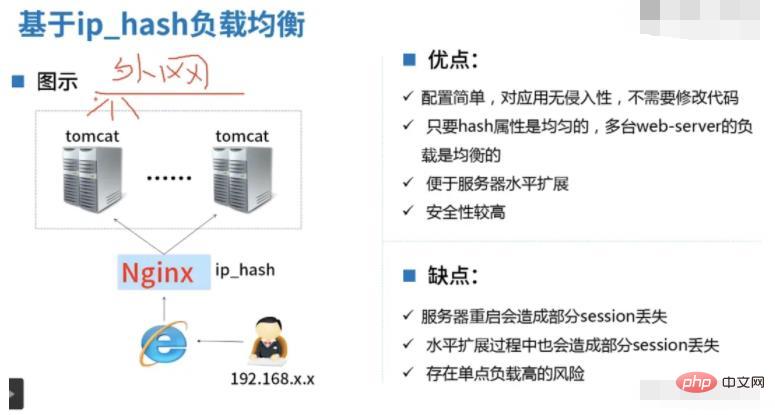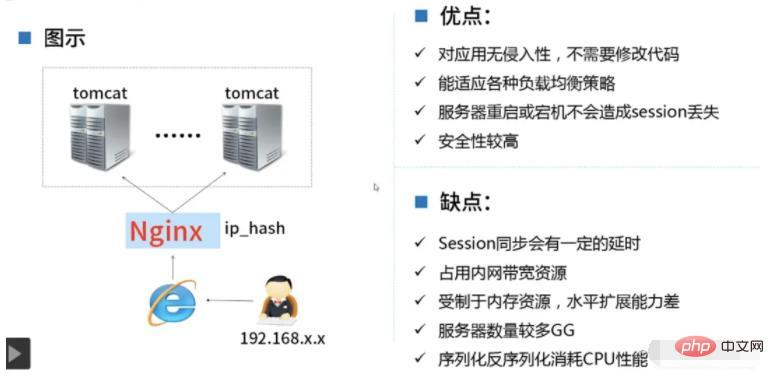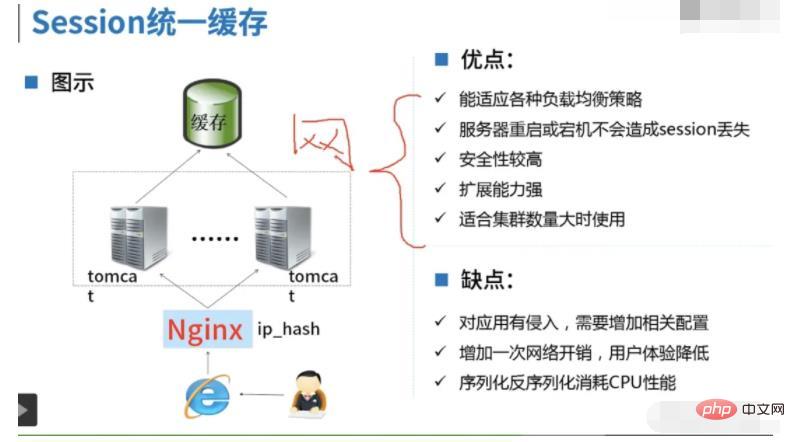Let's talk about four solutions for PHP session sharing
This article will introduce you to the knowledge related to PHP session. Let's start with why this session sharing solution appears. I hope it will be helpful to friends in need~
Understand first Why does this session sharing solution appear?
As the projects of Internet companies are built in microservices and distributed environments, a project may be deployed in several or even many server clusters. At this time, a Question:
When a user has a session, for example, a user logs in to a project. Generally, projects of large companies have Nginx for reverse proxy.
Here Let’s briefly list several reverse proxy strategies commonly used by Nginx:
Polling strategy, weight ratio strategy, ip_hash strategy, and customizable strategies,
In Nginx’s reverse proxy Under the proxy, the user's request is generally distributed to different servers. However, if the user's request is stored on the server A of the request, then the user's session ID is stored in a ConcurrentHashmap of the JVM on the server. Use sessionID as key.
But if a service module requested by the user at this time may need to be called to server B, when the user initiates the request, the user's session ID is not stored on server B at this time, so the user will be asked again Perform a login operation. It may also lead to a situation where the user originally wanted to complete an order operation, but logged in several times.
So the session sharing solution is particularly important in distributed environments and microservice systems. [Recommended learning: "PHP Video Tutorial"]
Solution 1: Nginx-based ip_hash load balancing
In fact, it is how much the requested ip address is to you Take the model from each available server, and then distribute your request to the corresponding server through Nginx's reverse proxy. (Here, the available servers will be put into an array. If the result obtained by taking the modulo is , the request will be assigned to the server with the subscript in the server array.)
Detailed implementation:
You need to make corresponding modifications in the Nginx.conf file, according to your own available server
upstream backend{
ip_hash;
server 192.168.128.1:8080 ;
server 192.168.128.2:8080 ;
server 192.168.128.3:8080 down;
server 192.168.128.4:8080 down;
}
server {
listen 8081;
server_name test.csdn.net;
root /home/system/test.csdn.net/test;
location ^~ /Upload/upload {
proxy_pass http://backend;
}
}The advantages and disadvantages of this implementation:

Solution 2: Session replication based on Tomcat
This solution is actually to copy the generated sessionID to all servers in the system when the user requests it, so as to ensure that when the user requests it, it will be copied from When server A may call a module on server B, it can also ensure that service B also has the user's session ID, so that the user will not be asked to log in again. That solves the problem.
How to implement session replication in specific code?

Advantages and disadvantages of using session replication:

Solution 3: Use Redis as a unified cache for cached sessions
This solution is actually to put the sessionID generated every time the user requests it on the Redis server. Then set an expiration time mechanism based on the characteristics of Redis, so as to ensure that users do not need to log in again during the session expiration time in Redis we set.
How to implement the code:

The advantages and disadvantages of using Redis to implement session sharing:

Solution 4: Combining cookies
In fact, you can also put the session in the cookie, because every time the user requests, his cookie will be put in the request, so this can ensure that every time the user When making a request, it can be guaranteed that the user will not log in twice in a distributed environment.
The above is the detailed content of Let's talk about four solutions for PHP session sharing. For more information, please follow other related articles on the PHP Chinese website!

Hot AI Tools

Undresser.AI Undress
AI-powered app for creating realistic nude photos

AI Clothes Remover
Online AI tool for removing clothes from photos.

Undress AI Tool
Undress images for free

Clothoff.io
AI clothes remover

AI Hentai Generator
Generate AI Hentai for free.

Hot Article

Hot Tools

Notepad++7.3.1
Easy-to-use and free code editor

SublimeText3 Chinese version
Chinese version, very easy to use

Zend Studio 13.0.1
Powerful PHP integrated development environment

Dreamweaver CS6
Visual web development tools

SublimeText3 Mac version
God-level code editing software (SublimeText3)

Hot Topics
 CakePHP Project Configuration
Sep 10, 2024 pm 05:25 PM
CakePHP Project Configuration
Sep 10, 2024 pm 05:25 PM
In this chapter, we will understand the Environment Variables, General Configuration, Database Configuration and Email Configuration in CakePHP.
 PHP 8.4 Installation and Upgrade guide for Ubuntu and Debian
Dec 24, 2024 pm 04:42 PM
PHP 8.4 Installation and Upgrade guide for Ubuntu and Debian
Dec 24, 2024 pm 04:42 PM
PHP 8.4 brings several new features, security improvements, and performance improvements with healthy amounts of feature deprecations and removals. This guide explains how to install PHP 8.4 or upgrade to PHP 8.4 on Ubuntu, Debian, or their derivati
 CakePHP Date and Time
Sep 10, 2024 pm 05:27 PM
CakePHP Date and Time
Sep 10, 2024 pm 05:27 PM
To work with date and time in cakephp4, we are going to make use of the available FrozenTime class.
 CakePHP File upload
Sep 10, 2024 pm 05:27 PM
CakePHP File upload
Sep 10, 2024 pm 05:27 PM
To work on file upload we are going to use the form helper. Here, is an example for file upload.
 CakePHP Routing
Sep 10, 2024 pm 05:25 PM
CakePHP Routing
Sep 10, 2024 pm 05:25 PM
In this chapter, we are going to learn the following topics related to routing ?
 Discuss CakePHP
Sep 10, 2024 pm 05:28 PM
Discuss CakePHP
Sep 10, 2024 pm 05:28 PM
CakePHP is an open-source framework for PHP. It is intended to make developing, deploying and maintaining applications much easier. CakePHP is based on a MVC-like architecture that is both powerful and easy to grasp. Models, Views, and Controllers gu
 How To Set Up Visual Studio Code (VS Code) for PHP Development
Dec 20, 2024 am 11:31 AM
How To Set Up Visual Studio Code (VS Code) for PHP Development
Dec 20, 2024 am 11:31 AM
Visual Studio Code, also known as VS Code, is a free source code editor — or integrated development environment (IDE) — available for all major operating systems. With a large collection of extensions for many programming languages, VS Code can be c
 CakePHP Creating Validators
Sep 10, 2024 pm 05:26 PM
CakePHP Creating Validators
Sep 10, 2024 pm 05:26 PM
Validator can be created by adding the following two lines in the controller.






